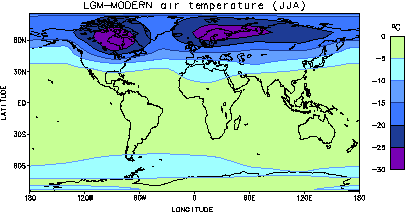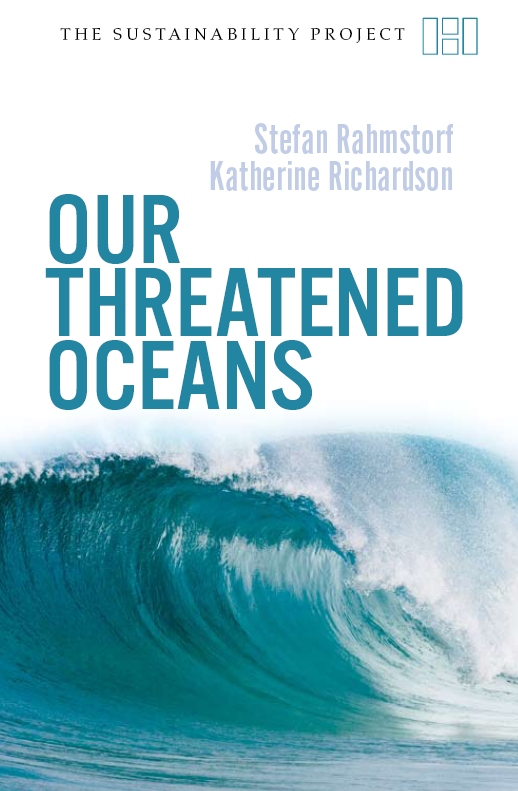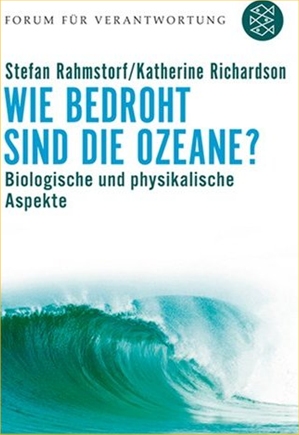A Model Ice Age
A team of scientists at the Potsdam Institute for Climate Impact Research has achieved a breakthrough in climate research. In a world first, they have produced a realistic computer simulation of the climate of the last ice age. A new climate model developed in Potsdam made the simulation possible. The climate it calculates corresponds closely with the picture of the ice age that has been built up over the past few decades from various data sources. The scientists were thus able to confirm that a climate model can accurately reproduce a climate considerably different from today's. "This is a decisive test of the credibility of climate models, on which also the climate scenarios for the next century are based," said the leader of the research group, Prof. Martin Claussen. The simulation of the ice age is published in the latest edition of the journal Nature (Vol. 391, pp. 350-356, 22. January).
The last ice age reached its peak around 21,000 years
ago. Ice sheets kilometres thick covered the northern parts of America
and Europe. The ice cover reached down to Berlin; further south, a dry,
polar steppe extended as far as modern France. The reason for the periodically
recurring ice ages were slight changes in the Earth's orbit which caused
changes in the solar radiation reaching the Earth. But exactly how these
gradual and subtle changes in the distribution of solar warmth led to such
rapid and drastic glaciation is still one of Nature's unsolved puzzles.
The Potsdam research team have managed to make an important step towards
solving this problem. Their model shows that changes in ocean currents
were a crucial factor in the cooling of the climate during the ice age,
particularly in Europe. The entire Northern Hemisphere was on average almost
nine degrees Celsius colder than it is today, according t???o their calculations.
And three degrees of `this cooling were caused by a shift of the North Atlantic
ocean circulation. Some areas even cooled by more than 20 degrees as a
result of the altered currents. The model showed the changes in ocean currents
just as they had previously been reconstructed by geologists from ice-age
sediment cores. "The great importance of ocean currents for climate has
been impressively confirmed," said Stefan Rahmstorf, one of the authors
of the publication. Many climate researchers fear that in the coming century
a significant shift of ocean currents could occur again as a result of
human interference with the climate system, with serious consequences particularly
for northern Europe.
 |
| The diagram shows the air temperature cooling at the
height of the last ice age compared to today. Some regions of the Northern
Hemisphere were up to 30 degrees celsius colder than today, according to
the model calculation of the Potsdam scientists.
The diagram may be reproduced. To obtain a high resolution version of the image please contact Andrey Ganopolski, e-mail: ganopolski@pik-potsdam.de |
A crucial feature of the model is that it calculates currents in the ocean and the atmosphere together, and not - as in previous attempts to simulate the ice age - either only the atmospheric or only the oceanic circulation. Only by coupling ocean and atmosphere together can a climatic equilibrium be freely calculated without having to make assumptions about the surface conditions. Coupled ocean-atmosphere models with which such a simulation of the ice age is theoretically possible did already exist, but they require such a large amount of computing power that even th???e most p`owerful supercomputers can only simulate a period of a few centuries. Due to the sluggishness of the oceans, this is not long enough to reach a climate state very different from today's. In the Potsdam model, the weather - with its rapidly changing high and low pressure systems - is not calculated; instead the average climatic properties such as the monthly rainfall are computed directly. This makes the simulation of many thousands of years possible.
The scientists first tested their new model by simulating
the present-day climate. They achieved a high degree of accuracy without
having to use corrections in the coupling of atmosphere and ocean, which
many older models require. The way was thus clear for the simulation of
the ice age. The researchers prescribed the prevailing solar radiation
of 21,000 years ago, placed known masses of ice onto the continents, and
reduced the carbon dioxide content of the air to its ice age level (known
from ancient air bubbles trapped in the ice of Greenland). Under these
conditions, they set the model to simulate 5000 years, up to the point
where a new climatic balance was established. In the Potsdam simulation
the global average temperatures at the peak of the ice age were 6.2°C
colder than the present-day climate. The Northern Hemisphere was around
8.7°C colder than today, while the southern hemisphere was only 3.6°C
cooler. The results agree well with reconstructed temperature data derived
from sources like drill cores taken from the Greenland ice-sheet, ancient
pollen, and the annual growth rings of tropical corals.
Publication Details:
Ganopolski, A., S. Rahmstorf, V. Petoukhov and M. Claussen: Simulation
of modern and glacial climates with a coupled global climate model.
Nature, Volume 391, pages 350-356, 22 January 1998.
The Authors:
Andrey Ganopolski is a specialist in ocean and climate system modelling. Before joining PIK in August 1994, he worked at the International Institute for Applied Systems Analysis (IIASA, Austria) and at the Computing Centre of the Russian Academy of Sciences in Moscow. He is the principal designer of PIK's new CLIMBER climate model and performed the glacial climate simulations.
Stefan Rahmstorf is an expert on the role of the ocean circulation in climate change. Before joining PIK in March 1996, he worked at the Institute for Marine Research in Kiel (Germany) and at the New Zealand Oceanographic Institute. The glacial climate simulation was designed and performed on his initiative.
Vladimir Petoukhov is an expert in climate and atmospheric modelling. He is a guest professor at PIK. His permanent affiliation is with the Obukhov Institute of Atmospheric Physics in Moscow. In 1992-1994 he worked at IIASA. He is the main author of the atmospheric module of CLIMBER and participated in the analysis of the results of the glacial climate simulation.
Martin Claussen is professor of theoretical climatology
at the Free University of Berlin as well as head of the department of climate
research at PIK and head of the CLIMBER group. His expertise is climate
modelling with emphasis on atmosphere-biosphere interaction. He has participated
in the analysis of the results of the glacial climate simulation.
Further information can be obtained from:
| Dr.
Stefan Rahmstorf
Tel. +49-331-2781-160 E-mail: Rahmstorf@pik-potsdam.de |
Prof. Dr. Martin Claussen
Tel. +49-331-288-2522 E-mail: Claussen@pik-potsdam.de |













